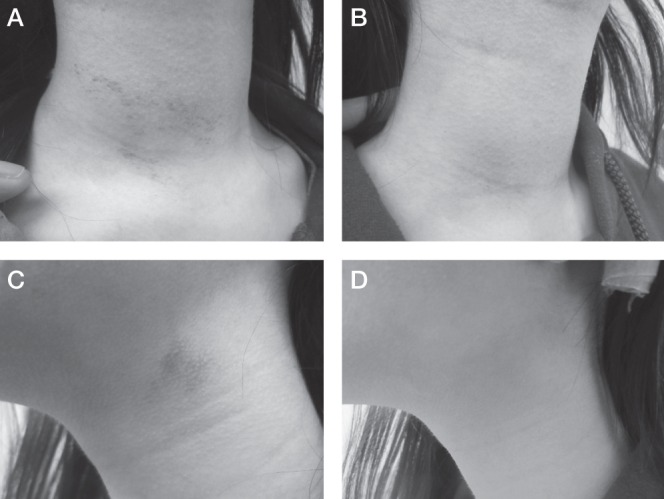A 12-year-old girl was referred for a two-month history of hyperpigmented lesions on her anterior neck. Her medical history was significant for treatment with clobazam for unprovoked seizure two months before appearance of lesions. She was otherwise healthy and family history was unremarkable. Physical examination revealed multiple brownish reticulated macular patches of hyperpigmentation on the anterior and lateral aspects of the neck (Figures 1A and 1C). Given the distribution and appearance of the lesions, a diagnostic manoeuvre was performed, which resulted in complete removal of the lesion (Figure 1B and 1D).
Figure 1).

Panels A and C demonstrate reticulate, hyperpigmented plaques on the anterior neck. Panels B and D demonstrate the same area after a diagnostic manoeuvre
CASE 2 DIAGNOSIS: TERRA-FIRMA FORME DERMATOSIS
The lesion was completely removed with firm rubbing with ethyl alcohol, establishing the diagnosis of terra firma-forme dermatosis. Terra firma-forme dermatosis is a benign cutaneous dermatological condition that affects children and adults with normal grooming habits, with common sites found to be on the neck and trunk (1). Typical presentation is of dirt-coloured patches and plaques that are resistant to conventional washing with soap and water, but easily treated with ethyl alcohol, which completely removes the lesions (1,2). Histological studies have revealed epidermal acanthosis and papillomatosis, as well as prominent lamellar hyperkeratosis (3). The differential diagnoses, which have varied clinical presentation, include pityriasis versicolour, a common superficial fungal infection; acanthosis nigricans, which is characterized by hyperpigmented, velvety plaques on the skin associated with a variety of systemic disorders, many of which are characterized by insulin resistance; dermatitis neglecta, in which the hyperpigmented lesions are due to inadequate cleansing of the skin, and soap and water are able to removed the lesion; and confluent and reticulated papillamatosis of Gougerot and Carteaud, a dermatosis of unknown etiology in which the hyperpigmentation is believed to be secondary to an increased number of melano-somes and treatment has been shown to be successful with topical tretinoin as well as oral antibiotics (1). Despite its typical clinical presentation, the disorder is not well known by physicians, which can lead to misdiagnosis, and costly tests and treatments as well as patient anxiety. Clinical awareness, therefore, provides simple and quick resolution while avoiding unnecessary investigations and therapies.
CLINICAL PEARLS:
Terra firma-forme dermatosis is a common entity but is often mistaken for conditions such as pityriasis versicolour and acanthosis nigricans.
It is not associated with poor hygiene and cannot be washed off with soap and water.
Rubbing with ethyl alcohol is an easy way to both confirm the diagnosis and to treat the lesion.
Contributor Information
Jasna Levi, Department of Family Medicine, University of British Columbia, Vancouver, British Columbia.
Joseph M Lam, Department of Paediatrics, Department of Dermatology, University of British Columbia, Vancouver, British Columbia.
REFERENCES
- 1.Akkash L, Badran D, Al-Omari AQ. Terra Firma forme dermatosis. Case series and review of the literature J Dtsch Dermatol Ges. 2009;7:102–7. doi: 10.1111/j.1610-0387.2008.06933.x. [DOI] [PubMed] [Google Scholar]
- 2.Berk DR. Terra firma-forme dermatosis: a retrospective review of 31 patients. Pediatr Dermatol. 2012;29:297–300. doi: 10.1111/j.1525-1470.2011.01422.x. [DOI] [PubMed] [Google Scholar]
- 3.Dalton SR, Pride GH. The histopathology of terra firma-forme dermatosis. J Cutan Pathol. 2011;38:537–9. doi: 10.1111/j.1600-0560.2011.01731_1.x. [DOI] [PubMed] [Google Scholar]


